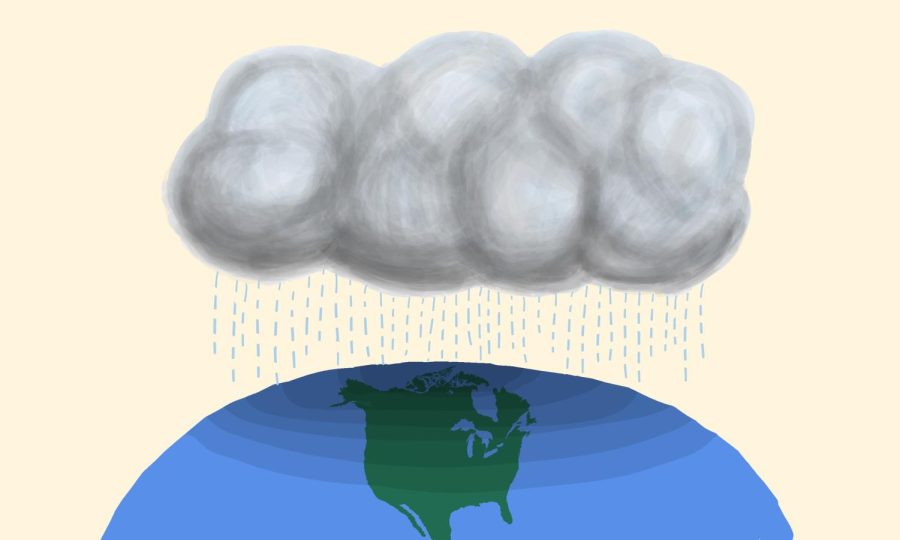Rain is falling harder in the US, Northwestern researchers find
Illustration by Lydia Tallarini
The research found an average increase in wet day precipitation by about 5% in the Central and Eastern U.S. during the studied periods.
November 3, 2022
Rain intensity has increased across the eastern two-thirds of the U.S., a trend that puts pressure on infrastructure and increases the risk of flooding, according to a recently published study by Northwestern researchers.
Using data from 1951–1980 and 1991–2020, the study found an average increase in wet day precipitation by about 5% in the Central and Eastern U.S. The increase is in the amount of rainfall specifically on wet days, rather than the amount of total rainfall across any day.
Ubben Postdoctoral Research Fellow at the Institute for Sustainability and Energy Ryan Harp, the lead author of the study, described the distinction as “nuanced.”
“When it rains, it’s raining about 5% more than it used to,” Harp told The Daily. “(Increased intensity) doesn’t necessarily mean that there’s more rainfall over the course of the year.”
While the study did not examine the causes for rain intensity increases, this trend fits into scientifically predicted consequences of climate change.
Earth and planetary sciences Prof. Daniel Horton is a co-author of the study and leads NU’s Climate Change Research Group. He said a temperature-rising planet means a wetter one.
“As an atmosphere warms, its ability to hold moisture increases at a rate of about 7% more water vapor for every degree Celsius,” Horton said. “We would expect because we’ve warmed as a planet … then our precipitation would also increase.”
More intense rain can increase the risk of flooding, Horton said. He explained that existing infrastructure may not be designed to handle changing weather patterns, potentially leading to drainage systems being overwhelmed.
Flooding in Chicago was caused by heavy rain soaked basements and overflowed pipes this September. It was the heaviest flooding in the region in two years.
“A lot of our infrastructure has been built around this assumption that the precipitation patterns and intensity that we’ve seen in the past will continue into the future,” Harp said. “That’s not the case.”
As cities develop, more land area becomes impervious to water. Rainwater is then unable to infiltrate through roads, parking lots and sidewalks into the ground, leading to more frequent floods.
McCormick professor emeritus Bill Miller founded the Center for Engineering Sustainability and Resilience, an NU organization which aims to address sustainability challenges.
“In natural areas where you have natural vegetation, anywhere between 80 and 100% of the water actually sinks into the ground rather than running off,” Miller said. “But in urban areas, essentially all of it runs off.”
In response to intense rain, some cities have turned to green infrastructure, which attempts to absorb rainwater before it can run off. In 2015, Evanston renovated the parking lot in the Lorraine H. Morton Civic Center to have water-permeable pavement.
Other factors, like geography, can determine how at risk a community is to flooding. Natural outlets for water to flow away from a city can reduce pressure on the city’s infrastructure.
Currently, Evanston faces a minor risk of flooding relative to neighboring communities, according to Lewis University Aviation Meteorology adjunct Prof. Rick DiMaio.
“The west side of Evanston drains into the McCormick canal, and the east side of Evanston drains into Lake Michigan,” DiMaio said. “So when we get really heavy-duty rains in Northeast Illinois, Evanston is one of the last places to flood.”
Nevertheless, as the climate changes, the risk to urban communities may continue to increase.
Horton said society can either adapt to more intense rainfall by renovating stormwater systems or by addressing the root of the problem.
“We know that the increase in precipitation is consistent with our predictions of what should happen with global warming,” Horton said. “So one thing we could do is reduce CO2.”
Email: [email protected]
Related Stories:
— Environ-mentality: Lake levels rising along with environmental damage
— Intense rainfall a concern at Environment Board meeting
— Despite speculation, Northwestern climate scientists say COVID-19 is not slowing climate change


